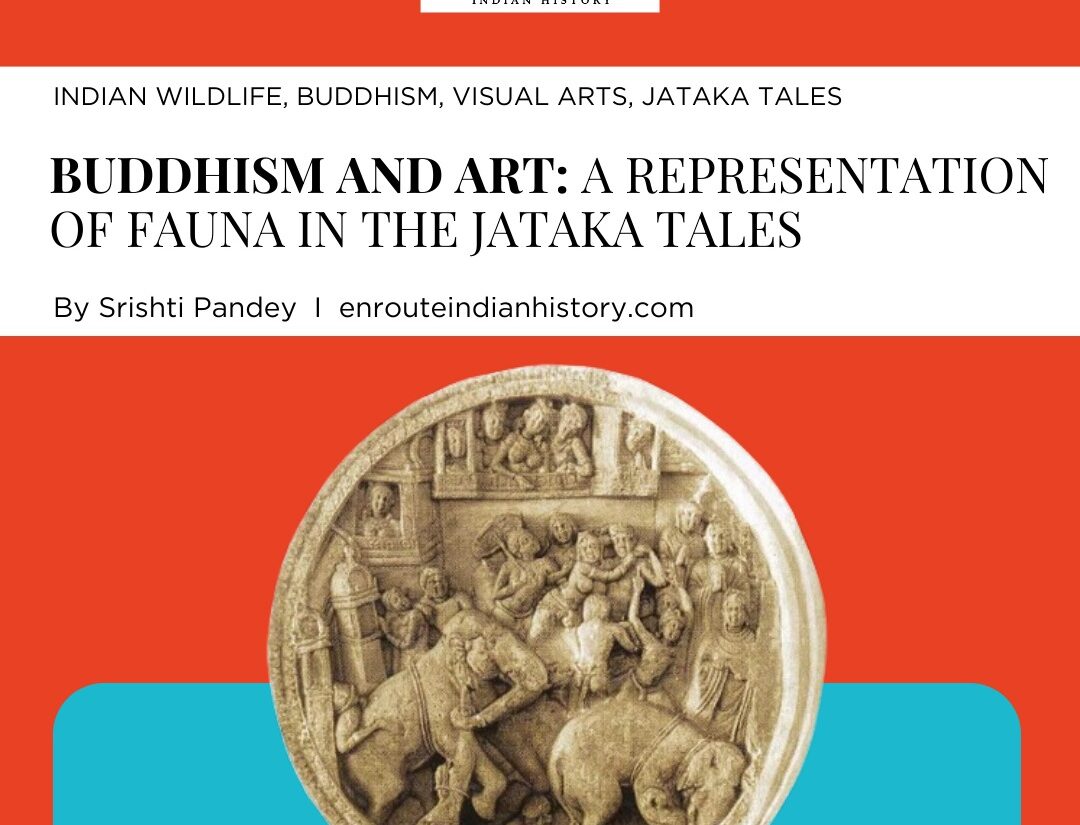
Buddhism as a religion has inspired people through generations and its emphasis on non-violence and inspiration to follow ‘Dhamma’ or Dharma (the right way of living) have guided the followers through history. The great Mauryan emperor Ashoka and his conversion to Buddhist ideals changed the course of history from violence to peace. The foundation of Buddhism was laid by Gautama Buddha. Born as Siddharth in Lumbini (Nepal) he was the son of King Suddhodana and Queen Maya. His encounters with an ill man, and an old man amongst others have been recounted in history and so are his sermons (the first was at the deer park in Sarnath) and how he attained enlightenment under the Bodhi tree in Gaya. Over the years Buddhism came to be divided into three subgroups Theravada, Mahayana and Vajrayana.
Every religion has its sources which pass information to the devotees about the life and times of their Guru or God. In the case of the Buddha, he was a teacher. In Hinduism we have the Bhagwat Purana (which focuses on the life and time of Lord Krishna) and Sikhism has the Janam-Sakhis (the life stories of Guru Nanak Dev). Buddhists have their treasure house of information regarding their Buddha in what are known as the ‘Jataka Tales’. Jataka means “Birth” in Pali and Sanskrit. The Jataka tales can be considered to be the auto-biographies of the Buddha and in every story, he appears as a different animal. The Buddha has been referred to as a master storyteller and it is believed that if there is one person who remembers all his previous births then it is him. The animals in the Jataka tales have been depicted as having a common origin and so there is no classification of inferior and superior. Numbered at 550 the Jataka tales are a part of the ‘Khuddaka Nikaya’ of the Suta Pita from Buddhism. The Jataka tales cover 70 animals and from amongst the Indian wildlife the greatest number of references have been made to the monkey (27), Elephant (24), Jackal (20), Lion (19) and Crow (17). The fauna in the Jataka tales is also shown to be expressing compassion.
BUDDHISM AND VISUAL ARTS
The Jataka tales have been visually represented in Buddhism. Visual arts have played an important role in Buddhism as this was the simplest way of enlightening the followers regarding the previous lives of their Buddha. Visual arts allow the followers especially if they are not literate to understand the story because as they say a picture speaks a thousand words. By viewing the art, the audience is made aware of the stories and tales from the Jatakas.
The Buddhist art is a beautiful world of sculptures and paintings. The earliest Buddhist art was very different from the visual narratives that are followed today. In the beginning, the Buddha was never showcased as a human. He would often find a representation in the form of a footprint and sometimes an empty chair would signify towards the Buddha. The change in the visual arts and its narratives came in the 1st century AD. It was then that a youthful Buddha with curly hair came to find a representation. The sculpture art also developed and that also took forward the tradition of the Buddhist visual arts. The art and the visual narrative from the Jataka tales also developed and they can be found at the caves, temples and the stupas (the stupas are the hemispherical mounds where the relic caskets containing the cremated relics of the Buddha were placed. The artists had switched from perishable mediums such as thatch and bamboo to stone in the 1st century AD to stone. The most popular themes were from the Jataka stories and the Indian wildlife finds a prominent representation in the art.
THE FAUNA IN BUDDHIST VISUAL ARTS
The Buddha’s relationship with the animals holds a special place in the textual and visual history of Buddhism. From being looked after by an elephant to actually taming a wild one in the Paraliyya forest the Indian wildlife features closely with the Buddha. The animals represent how the Buddha has been born multiple times. The tale of the taming of the wild elephant in the form of a visual narrative for the first time ever was found at the Amravati stupa. The sculptor has shown a wild animal charging towards the Buddha and then one views how he bowed down to the Buddha (Exhibit-1).
One stupa where the faunal depiction in Buddhist visual arts finds a distinctive and beautiful narrative at the stupa of Bharhut. This stupa was discovered by Alexander Cunningham in 1873. Post the excavations the major part of the stone railings (which have representations of fauna from the Jataka tales) was relocated to the Indian Museum in Kolkata. The Jataka tales have been labelled in Prakrit inscription in the Brahmi script. At the same stupa, one can find the depiction of the monkey who risks his life to save his troop and unfortunately, he loses his life at the end (Exhibit-2). This tale is from the Alarbusa Jataka. At Sanchi, one finds a plethora of visual arts which have depictions of Indian wildlife.
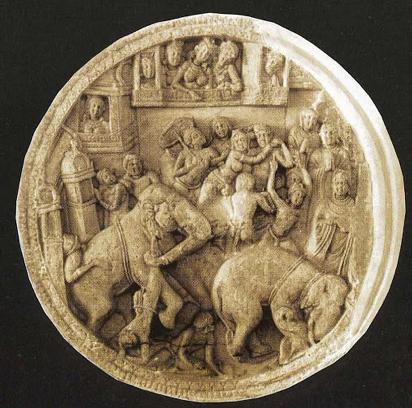
Exhibit-1: The Elephant charging and then bowing in front of the Buddha.
[https://prepp.in/news/e-492-amaravati-school-of-art-and-culture-notes]

Exhibit-2: Mahakapi Jataka (detail), from the Bharhut Stupa, Madhya Pradesh, c. 100 B.C.E., Sunga period, sandstone (Indian Museum, Kolkata; photo: Ken Kawasaki, CC BY-SA 3.0) [https://smarthistory.org/bharhut-stupa-relief-sculptures/]
The importance of the Indian wildlife in the Jataka tales is also evident from the fact the Buddha’s first sermon at Sarnath was actually in the deer park. The other animals which have found a depiction in the Buddhist visual narratives are varied and some prominent ones are discussed below.
Elephant
The elephants are considered sacred in both Asia and Africa. In Buddhism, they represent the time of the Buddha’s birth. As a symbol of beauty and dignity, the white elephant had come in the dream of the Buddha’s mother Queen Maya. The elephant had offered the queen a white lotus and entered her womb.
Lion
The lion represents the birth of the Buddha and also his bravery in challenging injustice. The Buddha is also said to have a loud voice which was loud, clear and powerful like the roar of a lion. In fact, he is also referred to as the ‘Shakya Simha’ or the lion of the Shakyas.
Fish
The fish is a representation of fertility, abundance and happiness. The teachings of the Buddha have been compared to the vast deep ocean in which the fishes reside. The golden fish especially is linked with one of the eight auspicious symbols of Buddhism which are known as the Ashtamangala. The golden fish is also considered to be a representative of the happiness and fearlessness which accompany enlightenment.
Peacock
A symbol of beauty, grace and immortality it is also a visual representation of the Buddha’s enlightenment. A peacock is said to have danced with ecstasy when the Buddha delivered his first sermon at the deer park in Sarnath. A visual narrative is found at the Stupas of Bharhut and Sanchi (Exhibit-3).
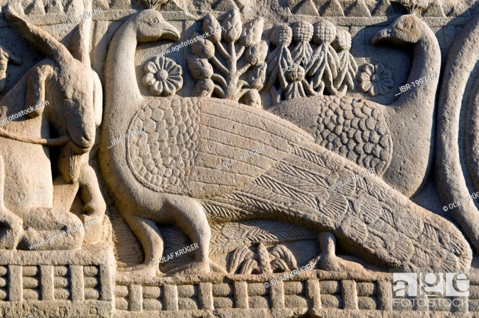
Exhibit-3: Stone carving, peacocks, stupas of Sanchi, a UNESCO World Heritage site, built by King Ashoka, Mauryan dynasty, Sanchi, near Vidisha, Madhya Pradesh, India.
[https://www.agefotostock.com/age/en/details-photo/stone-carving-peacocks-stupas-of-sanchi-a-unesco-world-heritage-site-built-by-king-ashoka-mauryan-dynasty-sanchi-near-vidisha-madhya-pradesh/IBR-1997467]
Snake
Symbolizing wisdom and healing in Buddhist art it is symbolic of protection. It is said that a snake had protected the Buddha from the rain when he had been meditating under a tree.
Cock
The cock has been depicted at the stupa of Bharhuth and is a part of the ‘Kukuta Jataka Katha’. It shows the kukkuṭ or the cock sitting on the branch of a tree while a cat that is sitting under the tree looks at the cock.
Pigeon
The Bharhut stupa also has a depiction of the pigeon which is from the Kapota (pigeon) Jataka Katha. Bharhut is a village located in the Satna district of Madhya Pradesh, central India. It is known for its famous relics from a Buddhist stupa.
As a part of the Sibi Jataka Katha, the pigeon has been shown sitting on the left side of King Sibi. This particular depiction is found on one of the panels in Ajanta’s cave number 1.
Crow
As a part of the Kapota Jataka Katha and the Laopta Jataka Katha, the crow finds a representation through the visual arts in Buddhism at the stupa of Bharhut. The tale visually recounts how a crow lost his life owing to greediness. As a part of the Latuka Jataka Katha, the crow helps the Latuka bird in taking revenge from a mighty elephant. The crow’s pointed beak causes the elephant to go blind. At Taxila, there is a crow-shaped bead made from agate stone at the site of Sirkalpa at Taxila. The panel at Ajanta’s cave number 17 shows the crow flying over the heads of female demons.
Crab
At the Bharhut stupa, structures are from the period of the Maurya’s. The panel from the Naga Jataka tale represents a crab, a fish and an elephant (Exhibit-4). The crab has been depicted as catching the legs of the elephant in its deadly claws. The elephant who has come to drink water from the lake is actually a visual representation of the Bodhisattva. The wife of the Bodhisattva requests the crab to let go of her husband and he does so. Upon being freed the Bodhisattva kills the crab under his mighty feet and creates a safe environment for the other elephants.
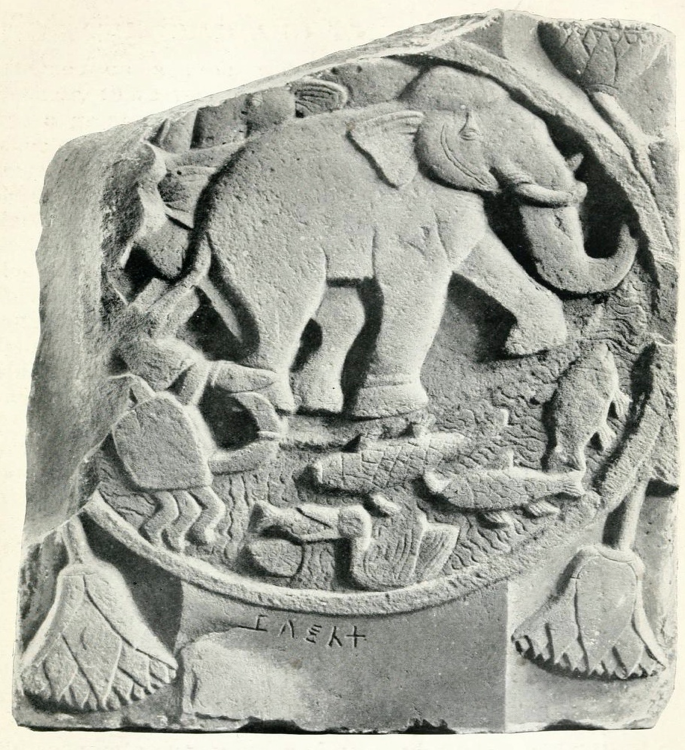
Exhibit-4: The Elephant and the Crab
[https://mythfolklore.blogspot.com/2015/11/story-of-day-crab-and-elephant.html]
Otter
Interestingly a panel at the Bharhut stupa represents an otter. This scene from the Sasa Jataka shows the otter holding a fish in his mouth. Even the scene from the Uda Jataka has an otter carved on it. That depicts a story of how two otters are fighting over a fish and a fox by taking advantage of their fight runs away with the fish. The Sasa Jataka at the Goli and Nagarjunkonda Stupas are from the Gupta period.
Owl
The owl is often considered to be a negative symbol. However, one of the panels in Mathura from the 1st Century B.C. shows an owl sitting between two monkeys and this is from the Uluka Jataka Katha Exhibit-5). The monkeys are shown giving a bath to the owl as he has declared himself as the king of the birds.
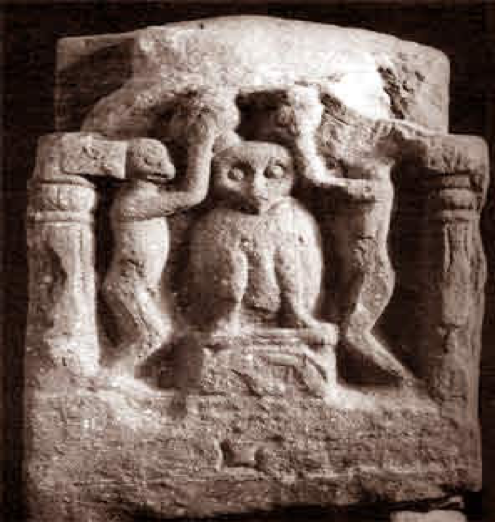
Exhibit-5: The Owl and the Monkeys
[https://yugpravantak.blogspot.com/2012/09/the-illustrated-jataka-other-stories-of_5559.html]
Buddhism has a plethora of visual art featuring the Indian wildlife from the Jataka Tales which find a representation in the stupas and caves and that is a classic indication towards the importance of the fauna in Buddhist art and literature. The fauna has been very important in Buddhism and the Buddhist visual arts will continue to keep the legacy associated with the fauna alive for years to come.
REFERENCES:
1. Vidya Dehejia, Department of Art History and Archaeology, Columbia University, February 2007, HEILBRUNN TIMELINE OF ART HISTORY ESSAYS, Buddhism and Buddhist Art, THE MET.
2. Animals Symbols in Buddhism, Studyofsymbols.com
- Nisaht Zaidi and Alok Bhalla, Reason and Purpose of the Jataka Stories, Mānoa, Vol. 27, No. 1, Story Is a Vagabond: FICTION, ESSAYS, AND DRAMA (2015), pp. 230-232 (3 pages), Published By: University of Hawai’i Press, https://www.jstor.org/stable/24637056
- Anand Singh, Buddhist Environmentalism: Narratives from the Jātakas, Journal of the Royal Asiatic Society of Sri Lanka, New Series, Vol. 60, No. 2 (2015), pp. 59-79, Published By: Royal Asiatic Society of Sri Lanka (RASSL), https://www.jstor.org/stable/44737022
- Florin Deleanu, Buddhist “Ethology” in the Pāli Canon: Between Symbol and Observation, The Eastern Buddhist, NEW SERIES, Vol. 32, No. 2 (2000), pp. 79-127. Published By: Eastern Buddhist Society, https://www.jstor.org/stable/44362259
- Abhay Kumar Singh, Indian History Congress Prize Essay: ASHOKA’S PERCEPTION OF NATURE AND MAN: A STUDY IN ART AND ATTITUDE, Proceedings of the Indian History Congress, Vol. 65 (2004), pp. 131-138 (8 pages), Published By: Indian History Congress, https://www.jstor.org/stable/44144727
- Stories from the Jataka, The University of Edinburgh; https://jatakastories.div.ed.ac.uk/
- Jeannine Auboyer (curator, Musee Gulmet Paris), The Jungle touched by a magic wand, Jataka Birth Tales, The UNESCO Courier, Twenty-Five Years of Buddhist Art and Culture, June 1956.
- https://prepp.in/news/e-492-amaravati-school-of-art-and-culture-notes
- https://smarthistory.org/bharhut-stupa-relief-sculptures/
- https://www.agefotostock.com/age/en/details-photo/stone-carving-peacocks-stupas-of-sanchi-a-unesco-world-heritage-site-built-by-king-ashoka-mauryan-dynasty-sanchi-near-vidisha-madhya-pradesh/IBR-1997467
- https://mythfolklore.blogspot.com/2015/11/story-of-day-crab-and-elephant.html
- https://yugpravantak.blogspot.com/2012/09/the-illustrated-jataka-other-stories-of_5559.html
- May 15, 2024
- 6 Min Read
























